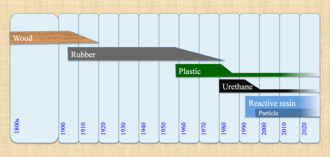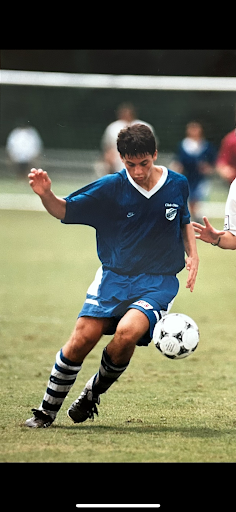Strikes and Gutters; The History of Bowling

There is nothing quite so embarrassing as falling over at the approach. Professional bowlers have their balls drilled to fit their hands perfectly so that mishaps like this never happen.
April 8, 2023
The cold rubber soles of your rented leather shoes press against your feet as you finish tying the unnecessarily long shoelaces. You step up to the approach and you firmly grasp the heavily scratched plastic ball that you took from a rack nearby, trying to get a good grip in its comically oversized finger holes. You hold the ball up with your dominant hand, trying to aim your upcoming shot down one of the arrows on the oily lane in front of you. You walk up to the line to throw your ball, and release your grip only for your ball to immediately fall into the gutter. Flustered, you turn to your friends in shame and assert that the ball fell off your hand.
For most casual bowlers, this can be a relatable experience on a Friday night spent out having fun with your friends. According to bowl.com, over 65 million people bowl each year in the United States alone. Bowling is a fun experience; seeing who can score the highest, trying to make difficult spares, enjoying some food from the snack bar, but it can also be a challenging one. Over the last century, bowling leagues and pro bowlers associations like the PBA, along with tens of thousands of consummate bowlers have pushed the game to its limits in high stakes competitions to see who can be the best.
Conceptually, bowling consists of 10 pins arranged in a triangle at the end of a 60 foot lane. The lane is covered in a pattern of oil that ends toward the end of the lane, this oil pattern differs between bowling establishments, and even to a smaller extent between lanes. The oil allows bowling balls to slide frictionlessly until they reach the end of the oil pattern, where they will then move in the direction they are spinning. This is how professional bowlers are able to throw their balls in a curve. The less oil there is on the lane, the more a bowling ball will curve.

The players try to knock down as many pins as possible in the two throws they have during each turn. Knocking down all 10 pins in one try is a strike, all 10 pins in two tries is a spare, and not knocking down all 10 pins after two tries is an open frame. A strike will multiply the two shots after it by two, and a spare will multiply the first shot after it by two.
Such an interesting game is not without an equally interesting saga of development. According to bowlingmuseum.com, the concept of bowling is almost 7000 years old, and examples have been found dating back from the height of the Egyptian age and Mesopotamia. The modern sport of bowling originates in Ancient Germany where it was played as a religious ceremony. The game was mainly played in Central Europe and Scandinavia before migrating to the United States, where it was introduced by German immigrants.
Once bowling came to the United States it started to evolve, according to sportslegacy.net, balls were made of rubber instead of wood and bowling establishments began to oil their lanes in order to protect them; this created the unintended effect of the ball curving at the end of the lane if thrown correctly. Bowl.com stated that this dynamic coupled with the introduction of automatic pinsetters in 1952 caused the popularity of bowling to explode in the United States. The NBC started airing bowling competitions and the Professional Bowling Association was formed.
It is not only the game that has evolved over the last centuries, the equipment has also changed. Westerville South Bowling Coach Jamie West stated that when he first started bowling, performance bowling balls were made of solid plastic. Eventually, balls changed to reactive resin and urethane compounds that increased how much the balls would curve further down the lane. The lanes themselves have also changed, West said that the change in ball technology also warranted a change in how the lanes are oiled. “Everything changed when they started bringing physics into bowling,” West said.

This change in equipment has made the sport easier for prospective players, but according to West, “The advancement of bowling equipment has removed a lot of skill, and you don’t need to do as much work to be good.” West compared the sport of bowling with golf, saying that both luck and skill are involved. Every time you throw the ball, it will react and hit the pins a little bit differently, West stated, “Your ball is at the mercy of the pins.”
Because bowlers focus on making precise adjustments and hitting very small targets, they must recognize the mental and physical aspects of the sport. Westerville South bowler, Hadasah Mensah, junior, stated that adjusting your foot by one board can affect your entire shot and “If you think you will not bowl good, you will not bowl good.” Another Westerville South bowler, Juston Anthony, junior, stated independently from Mensah that the most difficult part of bowling is mastering the mind game.
Bowling has been morphing and changing as long as it has existed, and there is no reason it will stop in the future. West said that “you can never make a cap on technology.” The Columbus Square Bowling Palace, of which West is the Assistant General Manager, has recently renovated its bowling equipment to a more modern interface called ‘Hyper Bowling,’ which incorporates touchscreen pads and different game modes. West said that the Palace has been aggressive in marketing and he has noticed an uptick in casual players.
Mensah and Anthony say they both plan to continue bowling beyond highschool, Anthony went so far as to state “I am going to bowl for the rest of my life, until I can’t bowl.”




